Sale Greyhound Racing Club
LCA: Wellington Shire Council
President: Les Hughes
Manager: Peter Johnston
Tel: (03) 5144 2148
Fax: (03) 5144 1910
Email: sale@grv.org.au
Website: sale.grv.org.au
Address: Sale Maffra Road
Postal: PO Box 44, Sale 3850
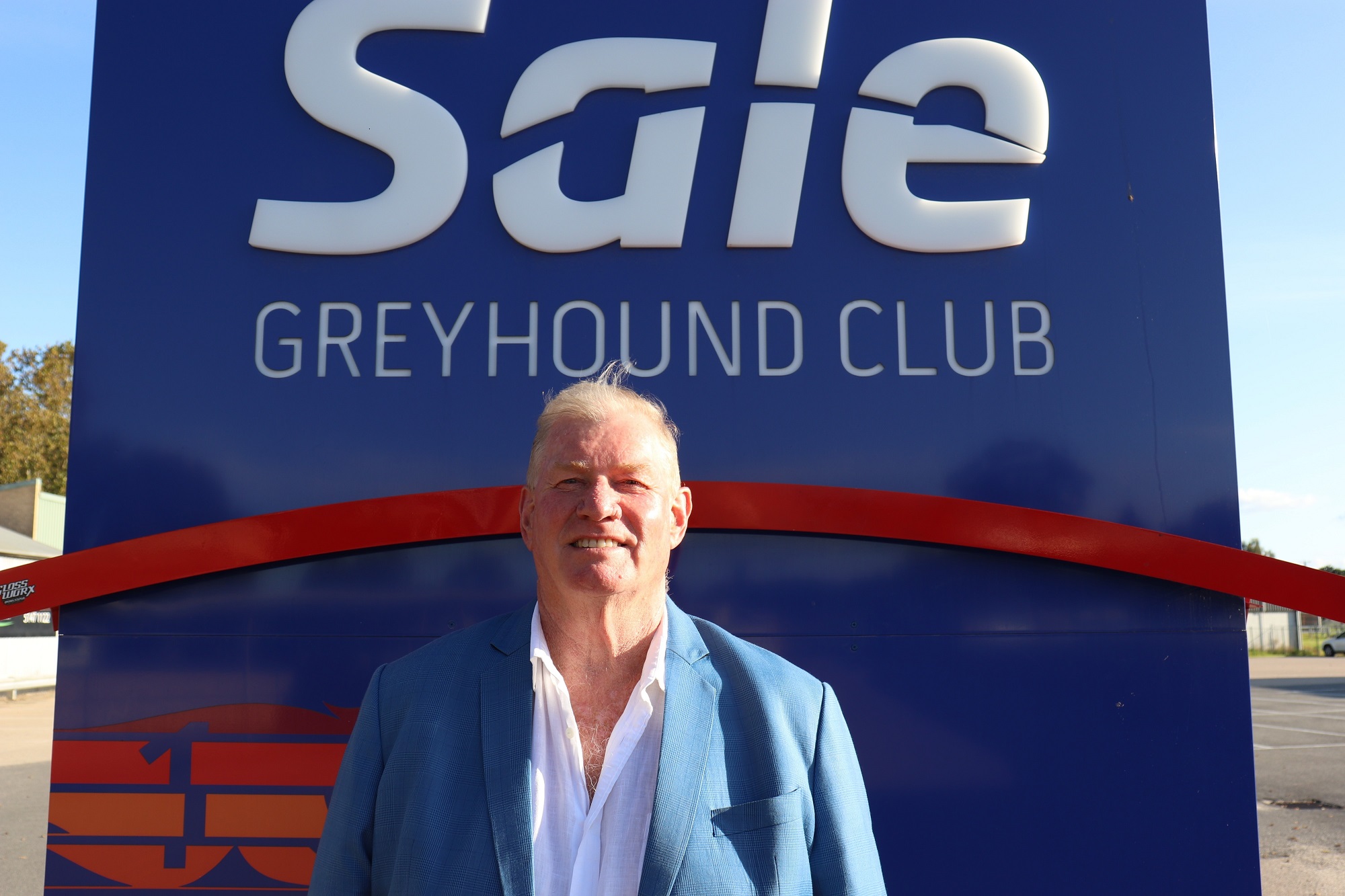
Peter Johnston grew up in Bairnsdale and attended Gippsland Grammar in Sale.
Pete started in hotel management when he left school but went back to university to study Farm Management and wool classing where he worked for 12 years.
Peter, his wife Sue and 3 daughters moved to Scone in Hunter Valley (opposite of a sea change ) where he managed clubs for 10 years before moving back to Bairnsdale. Peters favourite place to holiday is Merimbula and he gets there as often as he can.
Peters two great loves are his 3 grandchildren and the Geelong Cats. He is very highly regarded in the local football circles as President at WyYung Football netball club. With his proudest highlight in 2015 with 9 flags all netball teams and 3 football teams.
We are very lucky to have had Pete manage the Sale Greyhound club for the past 16 years, but please do not accept tips from him.
History of the Sale Greyhound Racing Club
In 1876, only three years after the holding of the first coursing meeting at Sunbury, a coursing club was formed at a meeting in the Club Hotel in Sale with authorization to purchase 50 hares at 10 shillings ($45) a head. In 1880, the North Gippsland Coursing Club (NGCC) was formed at a public meeting and it held the Australia Cup meetings on local estates in 1895, 1896, 1899 and 1902. The Gippsland Tlmes reported a large attendance at the 1896 meeting with hares being plentiful but difficult to draw into the open despite the efforts of the beaters.
Modern greyhound racing had its beginnings in 1920 when a meeting between the Sale Turf Club and representatives of the Sale Coursing Club discussed the possibility of a Plumpton course on the Sale Reserve. The course was to be 800 yards by 350 yards and with fencing on one side and wire netting on the other. A hundred hares were to be grazed on the enclosure.
The entrance charge was two shillings and nine pence ($4.75) for gentlemen and one shilling ($2) for ladies. Hares were supplied by holding hare drives, which had a social as well as practical aspect. Nine gallons of beer was supplied by the local brewery with corned beef (cooked by the ladies), butter, bread and cordial for the kids all being supplied by local merchants. Coursing continued until 1952 when the fencing was taken down and the 67 acres ploughed and planted with crops.
In 1921, the Lands Department approved the project and the course was built at a cost of 1000 pounds ($44,000). That year, the NGCC changed its name to the Sale Enclosure Coursing Club (SECC) and held its first meeting. The Gippsland Times reported that the Mayor of Sale, Tom Cullinan, and the MLA for North Gippsland, Jim McLachlan, both spoke of the importance of Sale coursing in the Australian context. It also reported that a high percentage of the hares were killed. By 1922 charges of cruelty to hares were appearing in the local papers and in 1924 the championship meeting had to be abandoned because the hares had been 'deliberately liberated'.
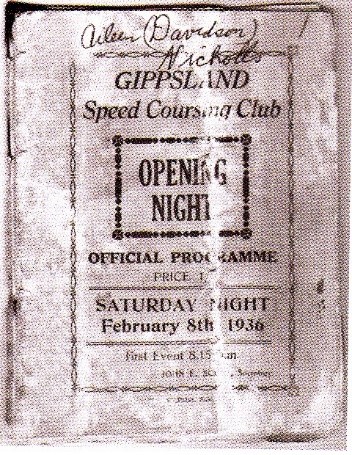 The Sale and District Greyhound Racing Club was formed in 1935 to conduct speed coursing with the first meeting conducted on Saturday the 6th February 1936 at the Sale Showgrounds. The speed coursing track was built by proprietary interests spending 700 pounds ($46,000) on the track equipment and the lighting. President of the proprietary Club, owned by the shareholders, was Jack Ponchi, Jack Scott was Club Secretary, Grader and Track manager. Prize money averaged 10 pound ($670) a race. The track was a straight track commencing at a point where McGhee St is today, running along the Dawson Street boundary. It also had a 340-yard circle track and races were conducted over the 250 yard straight and 340-yard circle. Hurdles were conducted on the straight track. Twelve hundred patrons paid a total of 85 pounds ($5700) on opening night to see the first race won by Nulla Nulla trained by Mr. Frank Gooding.
The Sale and District Greyhound Racing Club was formed in 1935 to conduct speed coursing with the first meeting conducted on Saturday the 6th February 1936 at the Sale Showgrounds. The speed coursing track was built by proprietary interests spending 700 pounds ($46,000) on the track equipment and the lighting. President of the proprietary Club, owned by the shareholders, was Jack Ponchi, Jack Scott was Club Secretary, Grader and Track manager. Prize money averaged 10 pound ($670) a race. The track was a straight track commencing at a point where McGhee St is today, running along the Dawson Street boundary. It also had a 340-yard circle track and races were conducted over the 250 yard straight and 340-yard circle. Hurdles were conducted on the straight track. Twelve hundred patrons paid a total of 85 pounds ($5700) on opening night to see the first race won by Nulla Nulla trained by Mr. Frank Gooding.
The first meeting was enlivened by the additional attraction of camel races. Old timers of this era still reminisce about champion hurdler Calaby, trained by Buck Davidson. Calaby kept winning to the extent that he was handicapped so far behind, that part of the fence behind the boxes was removed to accommodate his starting box. The club progressed and soon moved to a new site with a grass track opposite the Showgrounds on the Princes Highway. In the early days, the club had a number of names. Originally it was the North Gippsland Coursing Club, then the Sale Enclosure Coursing Club then Sale Speed Coursing (since its first meeting on 8th January 1936) with each reflecting the change in the nature of the sport.
As with most clubs, times were tough during the depression and the club survived with only one meeting a month. Prominent owners were Jim Jennings, who won the 1938 Waterloo Cup and Victorian Derby and Tom Lannigan Snr., who won the St Leger and the Victorian Oaks with Shyanza. Today's Sale Greyhound Racing Club (SGRC) has conducted the Tom Lanigan Memorial for a number of years. The race is for greyhounds that have not won more than three races because Tom always saw himself as the battling trainer. Tom was also a Life Member of the SGRC.
In 2007 the late Artie Davidson remembered how he and his brothers raced greyhounds with live hares in the middle of Sale's racehorse track on a Plumpton Course similar to that at Maribyrnong's Napier Park. During WWII Artie who was Club Secretary, Charlie Hyatt who was President, Gordon Ogilvie and Arthur Hay ran four races for 3 pounds ($160) on a Saturday afternoon to keep the club going. While pleased to see the growth of the present-day industry, Artie derived his greatest satisfaction from keeping the sport going during the war years. The late Arthur Hay was also hare driver for the Club since the inception of the mechanical hare. His name is commemorated today in a special race.
Racing veteran the late Perce Martin who passed in 2017 at 101 years of age was at the opening of the original track when he was 20 years old. He worked milking cows and his employer had good Plumpton greyhounds, which were raced at the Sale racecourse through until the 1950s. He remembers seeing as many as eight Plumpton greyhounds being trained behind a baker's cart drawn by a horse. He took part in hare drives for the Plumpton mounted on a pony, driving the hares into a net. While there were rabbits by the thousands, they were normally too slow for greyhound coursing. The six hares he would catch were a good result for a day's work and would go to the Traralgon Plumpton as well as the local Club.
These hares were trained to find a safe exit from the Plumpton course, being chased by fox terriers before being used for greyhound coursing. The slower foxies had no chance of catching or injuring the valuable hare.
In 1967, Perce nominated the late Dave Gault, an engineer and successful local businessman as President, at a time when it looked as if the club would not survive. Perc, who was also on the Agricultüral Society Committee with Gault, hoped Gault's business acumen on issues such as banking and bookkeeping would bring success and stability to the club. In recognition of his work, the Agricultural Society named the pony show jumping area the Perc Martin Arena.
Greyhound Racing left the precincts of the Showgrounds for the only time in its 70-year history when, in the late 1940s, the Gippsland Speed Coursing Club sought greener pastures and moved across the Princes Highway to a site on Dawson Street. Racing was over both a straight 300 yard and 427-yard circle and this form of racing continued until 1955 when mechanical lure racing was finally legalized. Racing was conducted behind a pacemaker and a drag lure, rather than today's continuous cable system. This old system had to be carried back and placed at the start after each race.
Some of the enthusiasts who acted as officials and volunteers during this time were Don Clavarino, Arthur Hay, Alistair Kennedy (President), Jack Mitchell (Secretary), Ang. Patterson (Secretary/Manager), Bert Pooley (Secretary), Jack Lambourn (Groundsman), and Lure Drivers Knox French and Clem Adamson. Don Hayes was a Committee member for 20 years (1959 - 79) and also Vice President for two years. Freddie Booth and Len Colliver gave Don good greyhounds to train and this made him as a trainer.
He went out of greyhounds with the shift to the current track. He remembers the hurdles being particularly spectacular and popular. Don also remembers his dad entered a hurdle greyhound in a flat race and the greyhound kept jumping in the air every 20m, despite this, the greyhound finished second, beaten by a head.
Don's experience is typical of the sport at the time. Results were always uncertain: A member of the Traralgon Club in the mid-1950s, he had a greyhound finish seventh, but its number went up as first because the Judge had money on it.
Distance and travel time was not an obstacle. When Don Hayes worked at the RAAF base, he was typical of the dedicated owner trainer. He would travel to Sandown, race, and drive home and be up at 5am to walk the greyhounds. He would also fly to Bairnsdale to race. Like many kids who grew up in Sale, Don remembers Musical Jack who lived at the track and had a fabulous LP collection. The kids would hang around his hut listening to the music. Parents warned children not to go into Jack's hut on pain of death which only made it more attractive. Don also recalls how Arthur Hay, a local trainer got drunk one afternoon and had an argument with his wife before taking his gun greyhound, Bluey, to the track. He and his mates put all their money on Bluey. His angry wife went to the crossroads where the gate to the track was open. When the greyhounds came past with Bluey in the lead, she called "Hey Bluey, here Bluey". The obedient greyhound stopped chasing and ran over to her. Moral "Don't mess with the hand that feeds the greyhound”
On the 17th August 1963, greyhound racing returned to the Showgrounds, racing on a track constructed around the main Showgrounds arena. Compared to the modern facilities enjoyed by patrons at Sale Greyhounds in the 21st century, the conditions in the 1960s could best be described as spartan. Racing changed from Saturday afternoons to Saturday nights with an uncovered betting ring and no form guides but a great atmosphere. The old paling fence was the only weather protection and on the really wet nights the bookmakers would field in the Grandstand. The Track was constructed using only volunteer labour who dug all the postholes by hand. Much of the equipment to build this new venue was second hand with the lights, judges' tower (still standing) and the wooden starting boxes being relocated from the old MGRA North Melbourne track at Arden Street. Robert and Wayne Wynd were involved when the old track grandstand was transported over. Getting the Showgrounds up and running over the weekends while racing at the old track required a huge effort on the part of the volunteers who worked while the wives would bring BBQ lunch and the kids would play around the track.
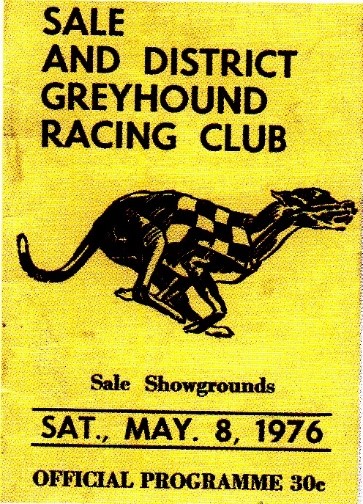 The new track's circumference was 470 yards with race distances being initially 400 yards and 545 yards with a 622 yards start being added later. The track was officially opened by Sir Herbert Hyland MLA with Councillor Ossie Ruff representing the City of Sale. The first race at the track was won by Dans Dian, trained by Arch Rowley. It is interesting to note that Dan's Dian came out of Box 1 but wore the yellow rug. In those days, the rug colours were allocated based on the original grading selection order but the box draw was not conducted until just prior to the first race which meant that rug colours and numbers did not necessarily correspond to box numbers as is the case today.
The new track's circumference was 470 yards with race distances being initially 400 yards and 545 yards with a 622 yards start being added later. The track was officially opened by Sir Herbert Hyland MLA with Councillor Ossie Ruff representing the City of Sale. The first race at the track was won by Dans Dian, trained by Arch Rowley. It is interesting to note that Dan's Dian came out of Box 1 but wore the yellow rug. In those days, the rug colours were allocated based on the original grading selection order but the box draw was not conducted until just prior to the first race which meant that rug colours and numbers did not necessarily correspond to box numbers as is the case today.
On 30th June 1970, a charity meeting was held at Sale to raise funds for Miss Maree O'Sullivan, an entrant in the Miss Australia Charity Queen contest. The feature event was the NCA Free to All which featured the State’s best stayers - Luxury's Son, Traffic Talk, Suzy Capri, Sprite of Egypt, and making her farewell appearance the champion Miram Miss - all competing for a cassette player, toaster and a transistor clock. Kerrie Ferguson, daughter of the legendary Arthur Ferguson, came to racing early (she was dragged along to the old straight track when she was three) and with an impeccable pedigree. Her father, Arty, was the club grader for many years after Kerrie's mum died. As was often the case in country clubs, the jobs were shared out in the family. Arty's brother and his son ran the ticket box and had a great involvement in sport. She and her sister were unpaid secretaries for the club, typing up the letters to the Greyhound Racing Control Board (GRCB) for her dad. She remembers her father was a very fair and systematic grader who remained involved for many years, who also spent time on the Committee and continued his involvement for many years after that.
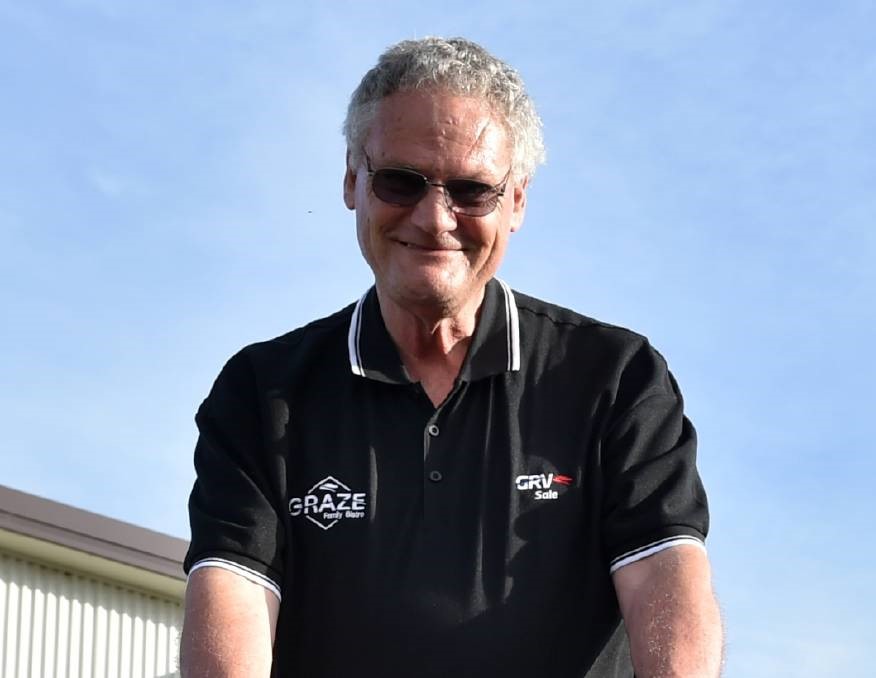 On Saturday night after the greyhounds, many trainers came to their house to nominate for the next week. While fair and systematic, Arty would give a man who was down on his luck a break according to Des Dooley. Des who served as President of the club 1995 -1997 then took over as Manager serving in that position from 1998 until 2019. Arty looked after locals and you knew that if you had had a lean run, Arty would give you your turn. Against this there was always pressure to make sure the fields were evenly matched to ensure the winner was not a stand out. This would ensure there would be even betting, and the bookies would give odds to encourage the punters to bet. Artie Davidson owned Winter Haven who ran in 116 races for 23 wins, 15 seconds and 25 thirds between 1975 and 1978.
On Saturday night after the greyhounds, many trainers came to their house to nominate for the next week. While fair and systematic, Arty would give a man who was down on his luck a break according to Des Dooley. Des who served as President of the club 1995 -1997 then took over as Manager serving in that position from 1998 until 2019. Arty looked after locals and you knew that if you had had a lean run, Arty would give you your turn. Against this there was always pressure to make sure the fields were evenly matched to ensure the winner was not a stand out. This would ensure there would be even betting, and the bookies would give odds to encourage the punters to bet. Artie Davidson owned Winter Haven who ran in 116 races for 23 wins, 15 seconds and 25 thirds between 1975 and 1978.
Yvonne Claverino, who married into a family with a long history in greyhound racing in Sale, is the wife of former Club Chairman Don. Her mother-in-law, Emily, was also President of the Ladies Committee, which has been running since the early 1950s. However, once the pokies arrived there was no need for these fund-raising activities and the long tradition of the Ladies Auxiliary faded. Her dad was in the RAAF and she met Don at the church social and he invited her to the track to watch his father's greyhounds. Her mum would have been horrified had she known of her daughter's introduction to greyhounds, but it was an introduction to a long involvement with the club.
Her future mother-in-law, Emily, helped with the kiosk and her sister Valda was also involved in the fund raising. Their contribution was significant. In the early 1960s, the Ladies Committee raised money to move the grandstand from the old track in a kiosk under the stand, which served soup and rolls at the meetings. They bought the lure with money from lucky number envelopes, chook and beer raffles. The kiosk also supported the volunteer effort when the ladies cooked for the volunteers working on the track while the kids played there.
In 1971, the plans for the new Sale complex went on the drawing board for the first time, some 11 years prior to the tracks opening. It was obviously a time of frustration that saw the end of Dave Gault's 13-year reign as President. Gault wanted a circular track like the Gabba in Brisbane and also like the one at Sandown. His domination of the club meant that this was the proposal that went to the GRCB where it was rejected.
At the instigation of the GRCB, Don, Noel Banks and Ned Wallish modified the plan while Dave was away. Yvonne remembers standing out on the track while they took measurements for the new proposal of a U-shaped track. The plan they drew up was accepted.
This meant there were considerable delays in the building of the new track. The Gippsland Times reported in 1975 that the track would cost $90,000 ($336,000) with racing to commence In early 1976 whilst a lift out supplement in the Greyhound Weekly dated 14th June 1979 forecast the opening meeting to be in December 1979. The new track did eventually open on 19th June 1982. Yvonne remembers the current track opening when a record crowd of 2000 was there to see Club President Peter Papworth hand scissors to Sports Minister Neil "Nipper" Trezise to cut the ribbon opening the new track. Originally budgeted to cost $116,000, the new track was completed at a cost of $500,000 ($1.9m). GRCB Chairman, Bill Crowley rated the facilities as the best outside the metropolitan area.
Yvonne's husband Don was Vice-President in 1984 when negotiations began with GRCB over the continuing viability of the club. Around this time, GRCB Chairman, Brian Halpin, gave the SGRC two three-month reviews with a view to closing it or amalgamating it with Traralgon. The club survived the reviews and as it had done in the past came back stronger than ever.
Don was very proud of his life membership, his Trainer of the Year Award in 1976, opening the new track and his record 33 winners in one year on the Sale track in a year when he had 64 winners all up.
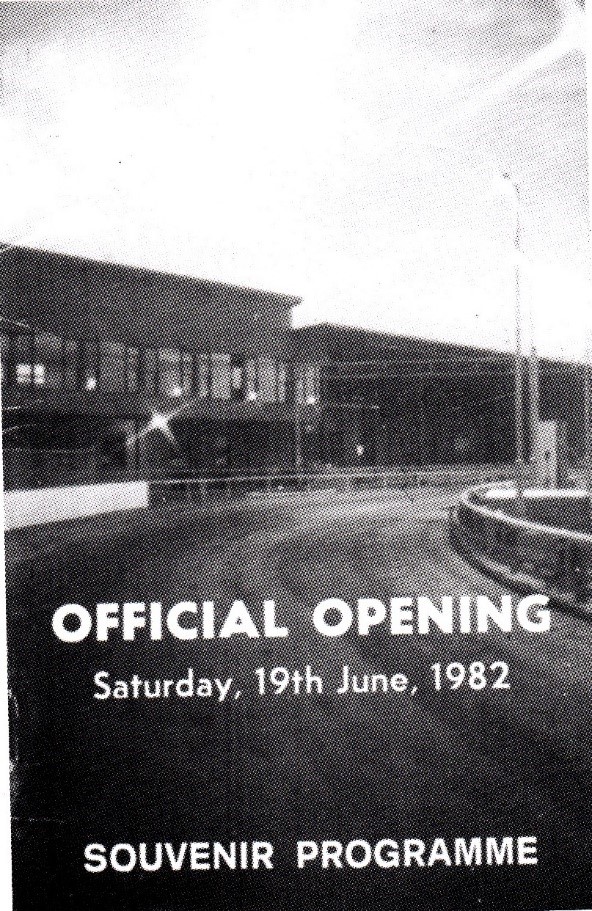 The popularity of greyhound racing continued to decline in the 1980s and despite great enthusiasm and hard work by the Committees of the time, crowds reduced significantly. On-course revenue was crucial to the Club's finances and to the Committee's credit they were not frightened to try different avenues to increase crowds and to raise money. Bingo commenced at Sale greyhounds and continues today with the Club having the best bingo following in the area. There was experimentation with afternoon racing and eventually the club became the first to race in the Saturday twilight timeslot, a radical move in an endeavour to gain TAB coverage. Sale was also the first Club to conduct Sunday twilights. A complete rebuild of the track and facilities was conducted in 1979 at the cost of $250,000 ($730,000) and the club raced successfully on that complex until moving to the current site, also located on the showgrounds in 1982.
The popularity of greyhound racing continued to decline in the 1980s and despite great enthusiasm and hard work by the Committees of the time, crowds reduced significantly. On-course revenue was crucial to the Club's finances and to the Committee's credit they were not frightened to try different avenues to increase crowds and to raise money. Bingo commenced at Sale greyhounds and continues today with the Club having the best bingo following in the area. There was experimentation with afternoon racing and eventually the club became the first to race in the Saturday twilight timeslot, a radical move in an endeavour to gain TAB coverage. Sale was also the first Club to conduct Sunday twilights. A complete rebuild of the track and facilities was conducted in 1979 at the cost of $250,000 ($730,000) and the club raced successfully on that complex until moving to the current site, also located on the showgrounds in 1982.
Racing commenced at the present complex on the 19th June 1982. Local greyhound, Southern Hunter, trained at Sale by late Dennis Sweeney, fittingly won the first race conducted at the new track. Development of the complex has been ongoing since this time and the current venue stands as a monument to the efforts and initiatives of past and present Committee and Management. The club has continued to be innovative and progressive in its approach. Free admission to the track for all meetings was introduced in the mid-1980s, the first time a Club from any code had offered permanent free admission.
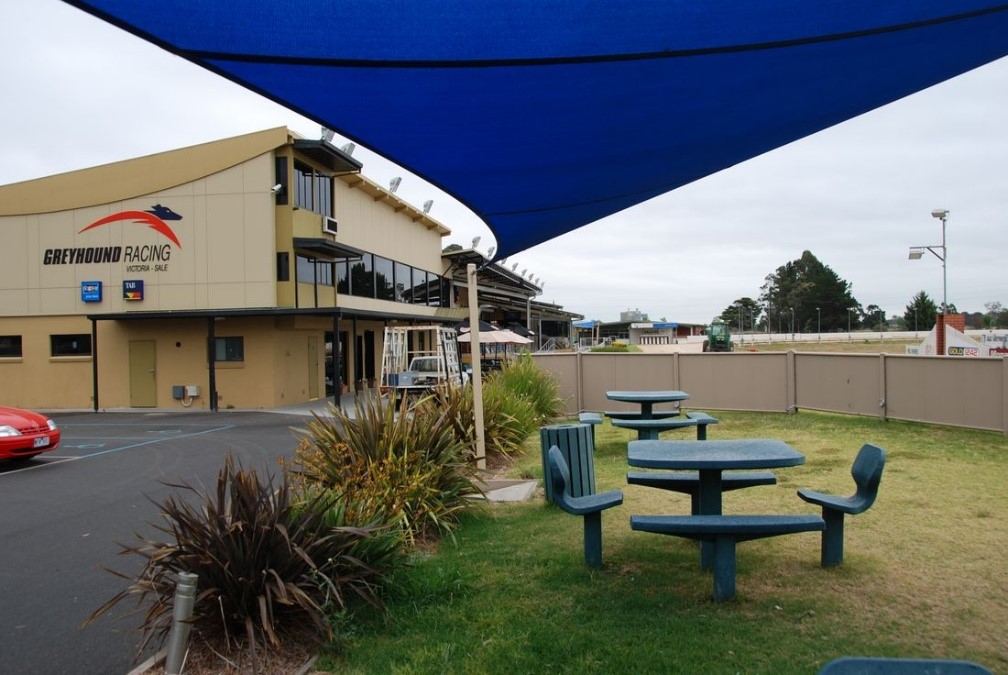 In the early 1990s, the single most important decision for the SGRC was made. With all Victorian clubs being asked to consider installing poker machines, only Sale, MGRA and Sandown took up the challenge. In early 2000, the SGRC took over the running of the Greyhound and Lure Restaurant as well as the 50 full time and part time staff employed there. The opening of the gaming room in July 1993 with 30 machines (now 80) has provided the funding and impetus for the club to be able to provide patrons with a facility described in the Metropolitan press as "The Moonee Valley of Greyhound Racing". With the racing and gaming areas complemented by a modern on-site restaurant and extensive asphalted and landscaped areas, there is tangible proof of the benefits of diversifying from the core racing product are seen. From a racing viewpoint, the change to 630 metres for the 2001 Sale Cup and a first prize of $20,000 was also a significant milestone.
In the early 1990s, the single most important decision for the SGRC was made. With all Victorian clubs being asked to consider installing poker machines, only Sale, MGRA and Sandown took up the challenge. In early 2000, the SGRC took over the running of the Greyhound and Lure Restaurant as well as the 50 full time and part time staff employed there. The opening of the gaming room in July 1993 with 30 machines (now 80) has provided the funding and impetus for the club to be able to provide patrons with a facility described in the Metropolitan press as "The Moonee Valley of Greyhound Racing". With the racing and gaming areas complemented by a modern on-site restaurant and extensive asphalted and landscaped areas, there is tangible proof of the benefits of diversifying from the core racing product are seen. From a racing viewpoint, the change to 630 metres for the 2001 Sale Cup and a first prize of $20,000 was also a significant milestone.
 The constant battle to survive was now turned around, as the pokies were a great help with the finances. Now a total of 70 full-time, part-time and casual employees are employed each week at the Sale greyhounds with trainers embracing the change to the present racetrack. A glance through the honour roll of the Sale Cup shows names like Chariot Supreme, Malawi's Prince, Wylie Boy, Awesome Assassin and Brookside Bear. The seemingly bold move in 2001 to run the Sale Cup over the 630m journey, with a first prize of $20,000, produced an outstanding result with brilliant front running stayer Bentley Babe, etching her name on the Cup Honour role. In a lead up event to the Cup, top class Sydney Stayer Restless Stan deposed Awesome Assassin as the 630m record-holder lowering the time standard from 36.27 to a staggering 35.96 seconds. The current distance is 650 and the record is 36.66 held by Burn One Down.
The constant battle to survive was now turned around, as the pokies were a great help with the finances. Now a total of 70 full-time, part-time and casual employees are employed each week at the Sale greyhounds with trainers embracing the change to the present racetrack. A glance through the honour roll of the Sale Cup shows names like Chariot Supreme, Malawi's Prince, Wylie Boy, Awesome Assassin and Brookside Bear. The seemingly bold move in 2001 to run the Sale Cup over the 630m journey, with a first prize of $20,000, produced an outstanding result with brilliant front running stayer Bentley Babe, etching her name on the Cup Honour role. In a lead up event to the Cup, top class Sydney Stayer Restless Stan deposed Awesome Assassin as the 630m record-holder lowering the time standard from 36.27 to a staggering 35.96 seconds. The current distance is 650 and the record is 36.66 held by Burn One Down.
A major upgrade of the venue took place in 1998 and then the racetrack itself was completely rebuilt in 2004. Following a fire in the grandstand in 2004, further extensive renovations took place and in 2006 another major refurbishment of the Tabaret was completed. The works further enhanced the Sale Greyhound Club's reputation as one of the most progressive racing facilities in Australia.
The Sale club has been actively involved in charity work. The activities include Bingo on Monday, Tuesday, Wednesday and Friday’s. Fund raising for various charities has been running since 1990 which have raised many, many thousands of dollars, including involvement with the Nicholson Hotel and the Royal Children's Hospital, sponsoring sporting clubs from the Latrobe Valley through to East Gippsland by allowing them to use race nights and race names for fundraising at each Club; plus lending facilities free of charge to Community and Sporting Groups including Neighbourhood Watch, Heartbeat, Rotary, Local Schools, Anti-Cancer Council and Pony Clubs. The club also contributed $20,000 to the Building of Public Toilets on the adjoining Showgrounds in 2006, contributing $25,000 to assist Sale Agricultural Society and Gippsland Grammar School to have adjoining street sealed and in 2007 running Flood Relief Night raising $50,000 for East Gippsland flood victims. This community spirit has been reflected over the many years with fund raising a major priority of the club’s focus and initiatives. Illustrated again in early 2020 with efforts of assistance and fund raising for East Gippsland Bush fires.
The Sale Club also can boast as the only country club in Australia that has a Group 1 race. Run over 650 metres the Sale Cup in 2010 became the richest country cup in Australia with a first prize of $50,000 it attracts the best middle-distance performers from all over Australia. In 2011 it maintained its Group 1 status lifting the first prize to $75,000 which it has maintained since. The race is enormously successful run on Boxing Day each year catering to massive crowds. It stages a multitude of family activities and is one of the towns major yearly feature events.
With the success of the Restaurant and Poker machine venue the Sale Club has continued to renovate all parts of the outdoor and indoor areas of the complex making it the most advanced of any in country club in Victoria or for that matter nationally.
Club Presidents: Jack Ronchi 1936, Charles Hyatt 1960’s, Alister Kennedy 1966-1967, Dave Gault 1967-1979, Peter Papworth 1979-1983, Gordon Graeme 1983-1984, Laurence Cameron 1984-1987, Bill Sellings 1987, Barry Bailey 1987, Don Clavarino 1988, Stephen Clavarino 1988-1992, Don Clavarino 1992-1995, Des Dooley 1995-1997, Jenni Rowley 1997, Leigh Jennings 1997-1998, John Waugh 1998-2019 and Les Hughes 2019 to Present.
Fun Facts
Without any doubt the greatest greyhound to come from Sale is the mighty Temlee. Not only a racetrack superstar, the brindle powerhouse was to rewrite the record books in a stunning stud career, with a contribution that places him close to the best of all time. An incredible turn of events was behind the reason Temlee was whelped at all. On a trip to Tony Duke's breeding property in search of a well-bred brood bitch Sale greyhound racing identity Tom Davidson bought Temora Lee for $800, but due to injury she never raced in Victoria. Not long after the purchase Davidson passed away but prior to his death he requested his greyhounds be humanely put down. Fortunately, family members could not bring themselves to have this done and gave Temora Lee to friend and former Sale club President Barry Bailey. He was to choose unproven stud dog Tivoli Chief as the sire and although the litter was registered in the name of Mary Davidson, Bailey paid the stud fee and whelped down the litter. The late Ray Hocken brought Temlee for $135 and gave him to Sale Railway worker Frank Cray to rear and train at his Sale property. Early on Temlee became sick with a bad bout of Hepatitis and distemper. Cray treated the pup indoors for a number of weeks and if it wasn’t for that intensive care he would have been lost. The reward was the first time he trialled after breaking in was at Sale, Temlee ran just outside the track record.
Only two dogs in the history of the Sale Cup have broken the track record when winning the final. In 1984 Champion race dog and 83 Silver Chief winner Chariot Supreme recorded 24.35 for the 424 metres. Starting 4/5 on from box six he defeated Flying Fast and Linden South. Then in 1995, winner Wylie Boy broke the 511-track record running 29.31. From box one he beat Melbourne Cup winner City Blitz. Wylie Boy came back in 1996 and won the Cup again going on five months later to win the 96 Top Gun at Sandown.
